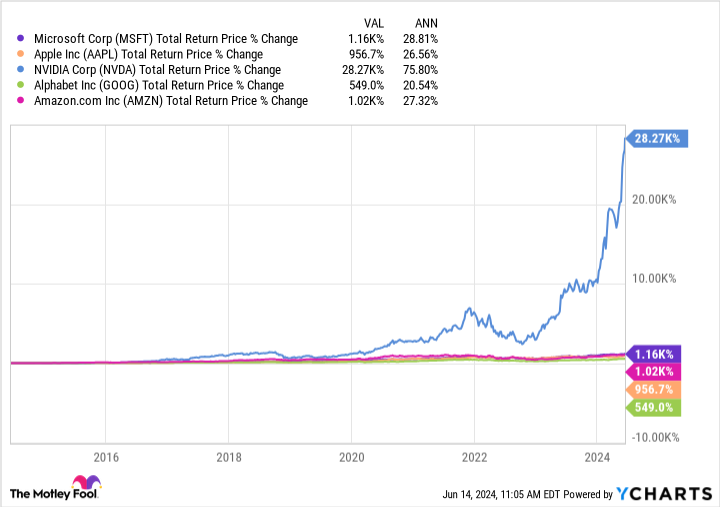By investing in an S&P fund, you can gain exposure to the broader U.S. economy and take advantage of its growth.
Beginning your investing journey can sometimes seem intimidating, especially if you pay too much attention to the noise of financial media. These voices will have you thinking that good investors must spend their time reading through financial statements and staying glued to investing programs on TV.
That couldn’t be further from the truth, though. Staying up-to-date on quarterly earnings has advantages, but for the most part, a beginning investor can build wealth over time with just a simple S&P 500 fund like the Vanguard S&P 500 ETF (VOO 0.08%).
So, what exactly is the S&P 500?
A stock market index is a collection of stocks theoretically grouped together by certain criteria. It could be company size, industry, location, or other relevant characteristics. The S&P 500 — the stock market’s most popular (and arguably most important) index — tracks 500 of the largest U.S. companies on the stock market.
Given the range of industries it covers and the importance of the companies it tracks, an investment in an S&P 500 index fund is often viewed as an investment in the broader U.S. economy. There are exceptions, but generally speaking, as the U.S. economy goes, so does the S&P 500.
That’s what makes an S&P 500 fund ideal for beginning investors; you don’t have to think too much, just trust in the long-term growth of the U.S. economy.
One investment that casts a wide net for investors
When you’re early on your investing journey and maybe still figuring out your investing style, a good route is to cover as much ground as possible, and this exchange-traded fund (ETF) allows you to do that. Here is how the ETF is divided by sector (as of April 30):
- Communication services: 9.1%
- Consumer discretionary: 10.3%
- Consumer staples: 6.2%
- Energy: 4.1%
- Financials: 13.1%
- Healthcare: 12.3%
- Industrials: 8.8%
- Information technology: 29.2%
- Materials: 2.4%
- Real estate: 2.2%
- Utilities: 2.3%
Larger companies make up more of the fund than smaller ones, so the tech sector is highly represented. Still, the fund does a good job of ensuring investors get exposure to companies from all sectors. It also contains stocks of all types, whether growth, value, or dividend-oriented.
Investors can also be certain they’re exposed to some of the world’s preeminent companies. The ETF’s top five holdings are Microsoft (6.83% of the ETF), Apple (5.83%), Nvidia (5.04%), Alphabet (4.18%), and Amazon (3.77%). Five companies make up over a quarter of the ETF, which isn’t as diversified as some would like, but these companies have been some of the stock market’s top performers over the past decade.
MSFT Total Return Price data by YCharts
With such innovations as artificial intelligence and cloud computing poised to drive tech growth for the foreseeable future, there should still be plenty of upside potential from the ETF’s top holdings and concentration in technology.
It’s hard to argue against the ETF’s long-term results
The ETF was created in September 2010 and has treated investors well, averaging more than a 14% annual total return since then. In fact, a $1,000 investment in the ETF at its inception would be worth over $6,300 today. Not too shabby at all.
VOO Total Return Price data by YCharts
Like any investment, there will be inevitable ups and downs along the way, but this ETF is one into which investors can feel comfortable making consistent investments over time, preferably using dollar-cost averaging.
Past results don’t guarantee future performance, but for the sake of demonstration, let’s assume the ETF’s average annual returns continue as is. Making $500 monthly investments could net over $1.08 million in 25 years, averaging 14% annual returns (including the ETF’s fees). Even the lesser 12% figure could net investors close to $800,000 after fees.
The ETF has an expense ratio of 0.03%, one of the lowest on the stock market. Investors can easily overlook an ETF’s expense ratio because the differences seem small on paper, but they can add up to a considerable amount of money. By investing in a low-cost ETF like this, you can keep more of your gains in your pocket instead of paying them out in fees.
Suzanne Frey, an executive at Alphabet, is a member of The Motley Fool’s board of directors. John Mackey, former CEO of Whole Foods Market, an Amazon subsidiary, is a member of The Motley Fool’s board of directors. Stefon Walters has positions in Apple, Microsoft, and Vanguard S&P 500 ETF. The Motley Fool has positions in and recommends Alphabet, Amazon, Apple, Microsoft, Nvidia, and Vanguard S&P 500 ETF. The Motley Fool recommends the following options: long January 2026 $395 calls on Microsoft and short January 2026 $405 calls on Microsoft. The Motley Fool has a disclosure policy.











